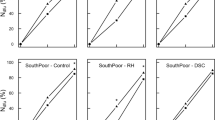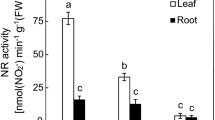Abstract
In forest soils, ammonium is usually the predominant form of inorganic nitrogen. However, the capacity of trees to utilize both NO3 - and NH3 + may provide greater flexibility in responding to changes of nitrogen supply from the environment. Such capacity has been studied in seedlings of Scots pine (Pinus sylvestris L.) and European larch (Larix decidua Mill.) grown in the presence or absence of either nitrate or ammonium. Nitrate-induced plants showed a higher nitrate uptake rate than non-induced plants; this difference was almost negligible after 24 h of exposure to NO3 -. Ammonium uptake in both species was consistently higher than that of nitrate, regardless of prior nitrogen provision. In both nutrient conditions, larch showed a more efficient transport system in comparison with Scots pine, with higher ammonium and nitrate uptake rates in both induced and non-induced plants. This was consistent also with the activity of nitrate reductase, measured in vivo in roots and leaves.
Similar content being viewed by others

References
Bassirirad H, Griffin K L, Reynolds J F and Strain B R 1997 Changes in root NH +4 and NO +3 absorption rates of loblolly and ponderosa pine in response to CO2 enrichment. Plant Soil 190, 1–9.
Cawse P A 1967 The determination of nitrate in soil solutions by ultraviolet spectrophotometry. Analyst 92, 311–315.
Kronzucher H J, Siddiqi M Y and Glass A D M 1995a Compartmentation and flux characteristics of nitrate in spruce. Planta 196, 674–682.
Kronzucher H J, Siddiqi M Y and Glass A D M 1995b Kinetics of NO +3 influx in spruce. Plant Physiol. 109, 319–326.
Kronzucher H J, Siddiqi M Y and Glass A D M 1996 Kinetics of NHC4 influx in spruce. Plant Physiol. 110, 773–779.
Kronzucher H J, Siddiqi M H and Glass A D M 1997 Conifer root discrimination against soil nitrate and the ecology of forest succession. Nature 385, 59–61.
Margolis H A, Vézina L P and Ouimet R 1988 Relation of light and nitrogen source to growth, nitrate reductase and glutamine synthetase activity in Jack pine seedlings. Physiol. Plant. 72, 790–795.
Marschner H, Hausslings M and George E 1991 Ammonium and nitrate uptake rates and rhizosphere pH in non-mycorrhizal roots of Norway spruce (Picea abies (L.) Karst.). Trees 5, 14–21.
Peuke D A and Tischner R 1991 Nitrate uptake and reduction of aseptically cultivated spruce seedlings, Picea abies (L.) Karst. J. Exp. Bot. 239, 723–728.
Seith B, Setzer B, Flaig H and Mohr H 1994 Appearance of nitrate reductase and gluatamine synthetase in different organs of theScots pine (Pinus sylvestris) seedlings as affected by light, nitrate and ammonium. Physiol. Plant. 91, 419–426.
Stadler J and Gebauer G 1992 Nitrate reduction and nitrate content in ash trees (Fraxinus excelsior L.): distribution between compartments, site comparison and seasonal variation. Trees 6, 236–240.
Weatherburn M W 1967 Phenol-hypochlorite. Reaction for determination of ammonia. Anal. Chem. 39, 971–974.
Rights and permissions
About this article
Cite this article
Malagoli, M., Dal Canal, A., Quaggiotti, S. et al. Differences in nitrate and ammonium uptake between Scots pine and European larch. Plant and Soil 221, 1–3 (2000). https://doi.org/10.1023/A:1004720002898
Issue Date:
DOI: https://doi.org/10.1023/A:1004720002898



